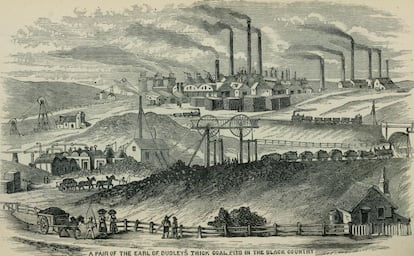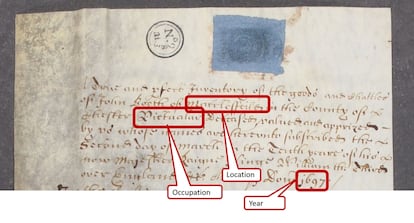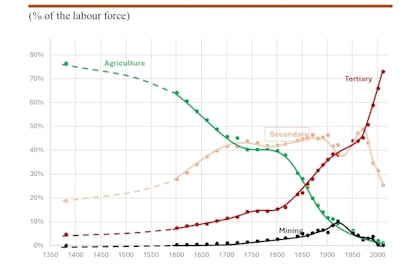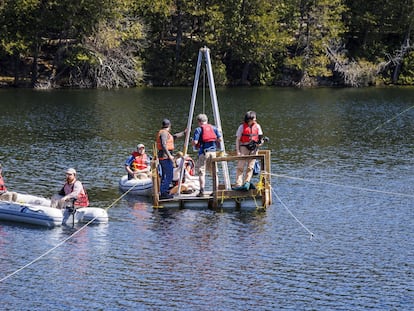Industrialization began in Britain a century before the Industrial Revolution
The compilation of millions of documents shows that agriculture had lost its hegemony to manufacturing long before the advent of the steam engine

History books date the beginning of the Industrial Revolution to the second half of the 18th century in England and Wales. As a milestone, they place at its altar the steam engine devised by James Watt between 1763 and 1775. But the accumulation of millions of census records made over two decades by historians at the University of Cambridge (UK) will force the rewrite of manuals and encyclopedias: As early as the 17th century, English people engaged in agriculture ceased to be the majority in favor of other occupations, such as manufacturing or services. Before the Industrial Revolution, there had already been a revolutionary change in the make-up of the labor force.
The classic division of labor establishes a distribution by sectors whose importance has been changing over time: the primary sector, for those related to farming and fishing; the secondary sector, centered on manufacturing and fabrication; and the tertiary sector, that of services, which has been traditionally referred to as the white-collar sector. There were always workers in all three (to which should be added a fourth dedicated to research and technology). But in England and Wales, a complex transition took place at the end of the 18th century and the beginning of the 19th century, the result of which was that primary activities, which had been the basic activities of all complex societies for millennia (since the Neolithic Revolution), were replaced by manufacturing and trade in manufactured goods. This new revolution, the Industrial Revolution, then spread to the European continent in the following century and, from there, to the rest of the world. Faced with this narrative, dozens of historians, supported by massive data analysis, have spent the last 20 years accumulating the evidence to rewrite history.
“By cataloging and mapping centuries of employment data, we see a need to rewrite the story we have told ourselves about the history of Britain,” says Leigh Shaw-Taylor, professor of economic history at Cambridge. “We have discovered a shift towards employment in goods manufacturing that suggests it was already industrializing more than a century before the Industrial Revolution,” adds the head of the Economies Past project, on whose website you can spend hours studying the evolution, chronology, geographical distribution and demographics of the Industrial Revolution. The site, its maps and statistics draw on 160 million documents from the early 14th century to 1911. Among them are parish archives, municipal archives, censuses, testamentary archives, death records... all in all details of several million people and what they did for a living.

Research shows that as early as the 17th century, the agricultural labor force experienced a sharp decline while the number of people manufacturing goods increased: from traditional local craftsmen, such as blacksmiths, shoemakers and wheelwrights, to the explosion of networks of local weavers producing cloth for wholesale. Specifically, while the rest of Europe, including mighty France and the German kingdoms and territories, continued to rely on subsistence agriculture, the number of male agricultural laborers in Britain fell by more than a third (from 64% to 42%) between 1600 and 1740. By comparison, 200 years later, in the 1930s, during the Second Spanish Republic, 47.3% of Spaniards worked in the fields. At the same time, by the end of the 17th century, the proportion of the male labor force involved in the production of goods increased by 50%, representing as much as that dedicated to farming (from 28% to 42%).
The fact is that the changes in the distribution of the labor force began as early as the 15th century, with the proportion of people engaged in agriculture continuing to fall until, in the first half of the 18th century, there were already more people engaged in manufacturing than in farming or tending livestock. In fact, at the beginning of the 19th century, when industrialization began to spread to the rest of Europe, spurred on by the steam engine and mechanization, in England the number of workers engaged in manufacturing had already been stagnant for some time. In an example that history is not as linear as it seems, many parts of Britain were even “deindustrializing,” the researchers say in a note.
In fact, there were several moments when the revolution seemed to be going backwards. By the mid-18th century, around the time Watts was perfecting the Newcomen atmospheric engine to form the supposed engine of the Industrial Revolution, much of southern and eastern England had lost its long-established industries and had even returned to agricultural work. For example, Norfolk was probably the most industrialized county of the 17th century, with 63% of adult males employed in industry in 1700. The figure fell to 39% during the 18th century, while those engaged in agriculture went from 28% of the total to more than half. Overall, the proportion of men engaged in manufacturing remained flat throughout the supposedly early and central phase of the Industrial Revolution, only to drop sharply from the early 20th century to the present day, when barely 25% of the workforce is engaged in manufacturing.
The chapter of the history books that talks about the emergence of the service sector will also have to be changed. For millennia, the labor force of the third sector was limited to administrative and military personnel and little else. Only in the late stages of the various industrial processes did the white collars of bankers, salesmen, lawyers, insurance agents, educators, and health workers begin to broaden their base until they became, in today’s societies, the majority. In today’s United Kingdom, almost 75% of work is related to the service sector, while the percentage dedicated to the primary sector is residual. Throughout the course of the 19th century, the service sector almost doubled in size.

Child and female labor
Another of the strengths of the project is that it has been able to separate and organize the data both by gender and by age. Thus, the researchers observed that female labor was central during the early stages of the revolution, but lost prominence during the 19th century and did not regain it until World War II. In 1851 in Easington, a village in the Durham coalfields, only 17% of adult women were employed. However, in one of the southern industrial centers — the hat manufacturing district of Luton — the figure reached 78%. “We believe that adult female labor force participation was between 60% and 80% in 1760, and fell back to 43% in 1851,″ Shaw-Taylor details in a note. “It didn’t return to those mid-1800s levels until the 1980s.”
When he wrote of children working in factories, Charles Dickens was only reflecting the harsh reality. Economies Past allows us to trace the relevance of child labor on the map of England and Wales. In the thriving textile mills of Bradford, in the north of England, more than 70% of girls between the ages of 13 and 14 were working in 1851. Sixty years later, this figure was still above 60%. Additionally, up to 40% of girls in the same area under that age were working in the looms. It was only with the introduction of legislation limiting child labor and instituting compulsory education for young children that their role in the Industrial Revolution was diminished.
“I don’t think our history takes anything away from the Industrial Revolution and the steam engine,” the British historian clarifies in a post. “What we are arguing is not that the Industrial Revolution did not take place between 1750 and 1850. What we are arguing is that the structural change in the labor force that was long assumed to have taken place between 1750 and 1850 actually ended in 1700.” For Shaw-Taylor, “this early industrialization paved the way for the technologically intensive Industrial Revolution (the shift to steam-powered machinery) that came later.” In a second part of the project, which already underway, the researchers aim to determine why this decisive process in history began in England and Wales, and not elsewhere.
Sign up for our weekly newsletter to get more English-language news coverage from EL PAÍS USA Edition
Tu suscripción se está usando en otro dispositivo
¿Quieres añadir otro usuario a tu suscripción?
Si continúas leyendo en este dispositivo, no se podrá leer en el otro.
FlechaTu suscripción se está usando en otro dispositivo y solo puedes acceder a EL PAÍS desde un dispositivo a la vez.
Si quieres compartir tu cuenta, cambia tu suscripción a la modalidad Premium, así podrás añadir otro usuario. Cada uno accederá con su propia cuenta de email, lo que os permitirá personalizar vuestra experiencia en EL PAÍS.
¿Tienes una suscripción de empresa? Accede aquí para contratar más cuentas.
En el caso de no saber quién está usando tu cuenta, te recomendamos cambiar tu contraseña aquí.
Si decides continuar compartiendo tu cuenta, este mensaje se mostrará en tu dispositivo y en el de la otra persona que está usando tu cuenta de forma indefinida, afectando a tu experiencia de lectura. Puedes consultar aquí los términos y condiciones de la suscripción digital.
More information
Archived In
Últimas noticias
Mexican peso defies uncertainty with forecasts of a new period of stability in 2026
Meghan Markle’s year of redemption: Numerous projects, some setbacks and a brand that is finally taking off
David King, chemist: ‘There are scientists studying how to cool the planet; nobody should stop these experiments from happening’
The end of the American dream gives way to Guatemalan opportunity
Most viewed
- Sinaloa Cartel war is taking its toll on Los Chapitos
- Oona Chaplin: ‘I told James Cameron that I was living in a treehouse and starting a permaculture project with a friend’
- Reinhard Genzel, Nobel laureate in physics: ‘One-minute videos will never give you the truth’
- Why the price of coffee has skyrocketed: from Brazilian plantations to specialty coffee houses
- Silver prices are going crazy: This is what’s fueling the rally











































